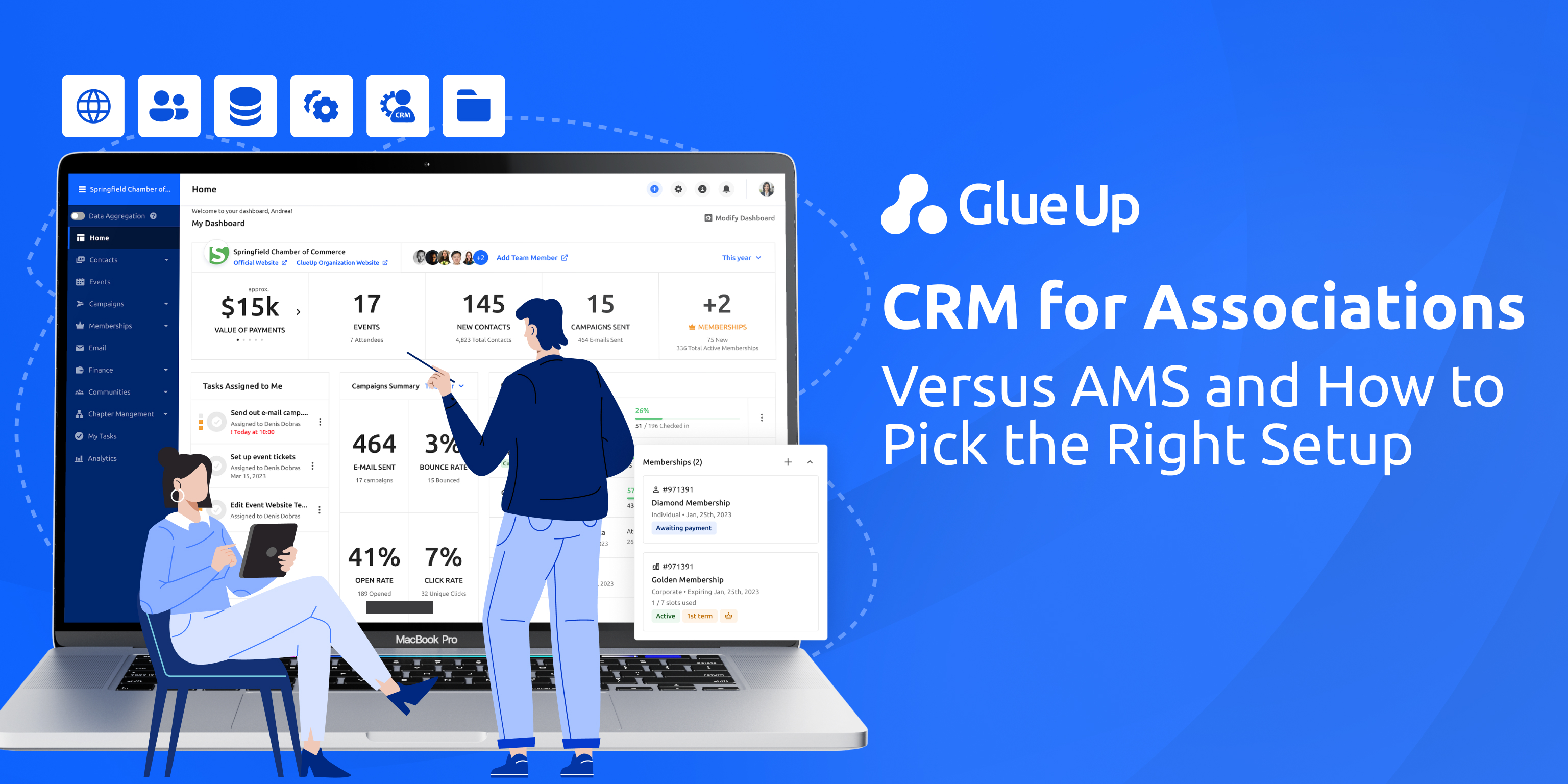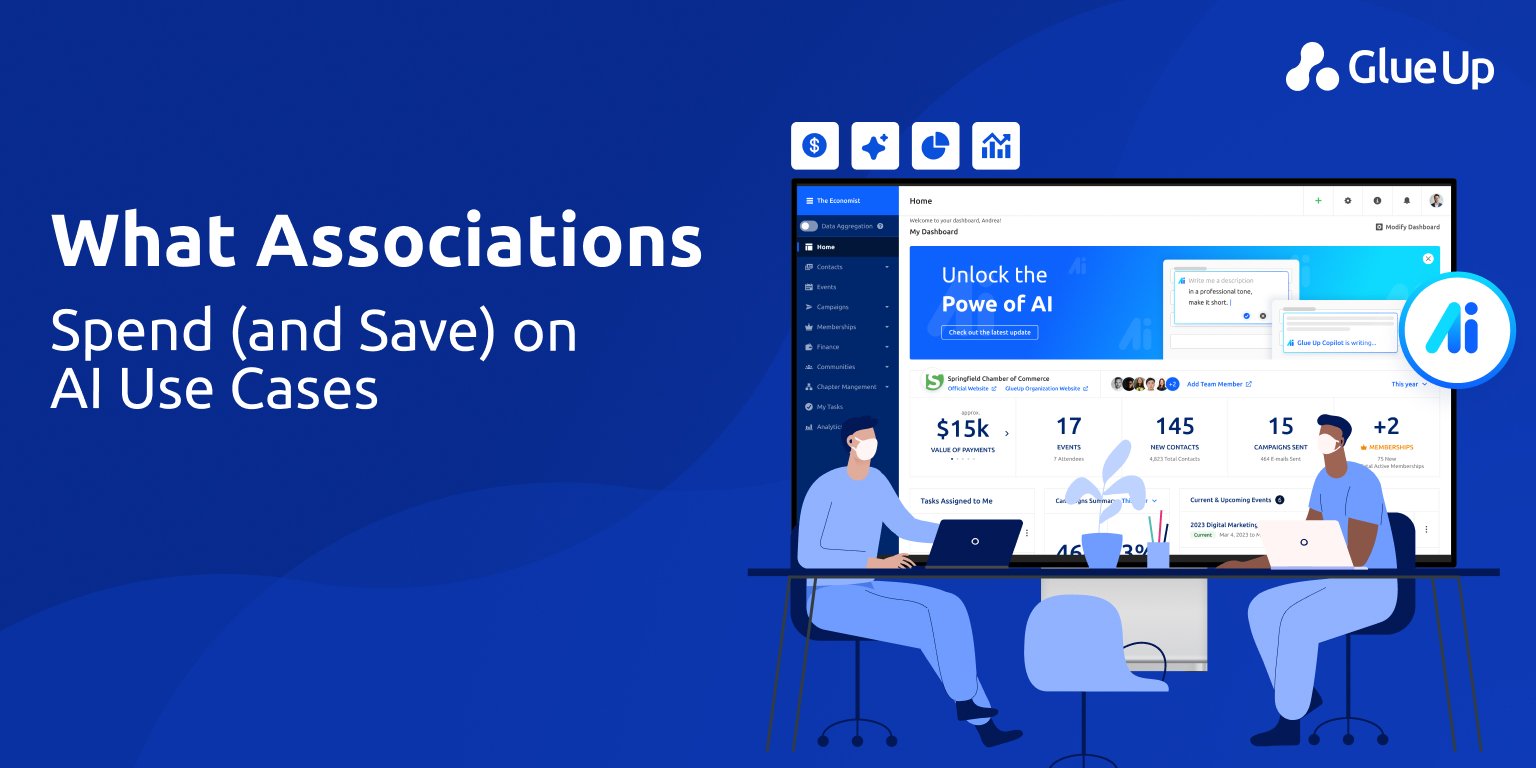
Picture this.
It’s Thursday afternoon, and you’re chasing a report for tomorrow’s board meeting. You open your association management software (AMS) to pull renewal data, your customer relationship management tool (CRM) for sponsor notes, and then a spreadsheet to reconcile event revenue. By the time you’ve stitched everything together, your coffee is cold and your confidence even colder.
That’s the modern AMS vs CRM dilemma. It’s about identity. Are you a membership organization running like a business, or a business trying to serve like a membership organization? The answer determines where your data should actually live, and why so many associations are realizing their systems quietly shape their strategy.
Key Takeaways
Pick an operating model. The AMS vs CRM choice should follow how you make money: dues, events, sponsorships.
Choose one of four clear patterns. Most associations fit one of these: AMS first with a light CRM, CRM first with AMS add-ons, a CRM-based AMS, or a dual-core setup with tight integrations. Each wins in different conditions, and each has tradeoffs.
Unify the revenue pillars. Dues, events, and sponsorships must feed the same record so you can answer board questions about conversions, ROI, and forecasting without exports, rework, or guesswork.
Governance beats customization. Define shared terms, data contracts, and adoption rules before you build. Clean data, clear owners, and standard processes save more time, money, and morale than “quick” custom fixes.
Glue Up reduces stack friction. With a unified data model, built-in automations, sponsor pipeline tools, finance ties, AI assist, and mobile access, Glue Up supports AMS vs CRM needs in one place and lets you scale without adding more tools, meetings, or manual reconciliations.
Quick Reads
The Scene Every Association Knows
At some point, every leadership team hits the same wall: “We have data, but we don’t have clarity.”
You can sense it when your board asks, “How many of last year’s event attendees converted into members?”, and no one has a quick answer. It’s the moment you realize the question is about architecture.
The truth is, AMS vs CRM is a map of how associations evolve. Some start operationally focused, tracking dues, registrations, invoices, then wake up realizing they can’t forecast or personalize. Others begin with CRM-style ambition, only to be overwhelmed by the complexity of renewals and chapter billing.
Either way, you eventually face the same fork in the road: keep patching tools or choose a setup that matches how your organization actually earns and sustains revenue.
The Origins of the Divide
The AMS was born from necessity. Decades ago, associations needed a digital ledger, something to track members, dues, and events. The CRM, on the other hand, came from business: a way to nurture leads, manage relationships, and forecast growth.
They speak different dialects.
The AMS cares about who belongs.
The CRM cares about who buys or engages.
AMS logic revolves around status, renewal dates, and eligibility. CRM logic revolves around pipeline stages, relationships, and activity timelines.
When organizations blur those worlds without intention, systems begin to contradict one another. A single person might exist as an “active member” in the AMS, a “prospect” in the CRM, and a “lead” in email automation, all technically true, yet collectively confusing.
The consequence is bigger than admin pain. It changes how you see your members. Are they customers, constituents, or community? That philosophical distinction quietly dictates every decision, from marketing cadence to revenue forecasting to retention strategy.
The Four Realities of AMS vs CRM
Most associations fall into one of four structural realities. Understanding which one you inhabit (or should inhabit) is the first step toward fixing the chaos.
1. AMS First With CRM Module
This is the traditional setup. You rely on a single AMS that offers a light CRM module for basic outreach and segmentation.
It’s ideal when dues and event income dominate your revenue, and your sponsorship model is straightforward. Everything lives in one database. Reporting feels consistent.
But the cracks show when you need sophistication: automated follow-ups, multi-stage pipelines, account-based marketing. The CRM module simply wasn’t designed for those nuances. Before long, your team exports data into Excel or external tools, creating new silos that defeat the “all-in-one” promise.
Glue Up insight: Many associations start here, then expand gradually. Glue Up often becomes their next step, a true AMS that includes powerful CRM capabilities without the limits of a plug-in.
2. CRM First with AMS Add-Ons
This pattern flips the script. You start with a commercial CRM, like Salesforce or HubSpot, and build AMS functions around it. Membership, events, and billing become custom modules or third-party extensions.
It works beautifully for growth-oriented associations where sponsorships, partnerships, and enterprise memberships drive revenue. You can run campaigns, automate sequences, and personalize communication deeply.
However, complexity skyrockets once you introduce renewals, proration, and accounting. Membership rules that AMS platforms handle natively become manual logic inside the CRM. Every upgrade or version change risks breaking your integrations.
Glue Up insight: For organizations in this camp, Glue Up can serve as the membership engine that connects seamlessly with an existing CRM, keeping both sides strong without over-engineering.
3. CRM-Based AMS
This is where the market is heading. It’s a hybrid, a membership platform built directly on a CRM foundation. You get the relationship depth of a CRM and the operational muscle of an AMS in one data model.
Everything: member records, sponsorships, event data; lives under the same architecture. Duplicates drop, analytics sharpen, and you gain what every board wants: a single source of truth.
Glue Up insight: This is Glue Up’s native design. The system was engineered as a CRM-based AMS from day one. That means your memberships, renewals, invoices, campaigns, and events all talk to each other automatically, powered by one unified record.
The advantage is foresight. When AI features, automation, or reporting upgrades arrive, they work across every module instantly.
4. Dual Core with Tight Integration
Some organizations intentionally run both: a specialized AMS for membership operations and a standalone CRM for sponsorship and engagement. With robust APIs and governance, this can be effective, especially for federated or chapter-based structures.
But dual core is also the most demanding. You must maintain field mappings, resolve duplicates, and constantly manage synchronization errors. It’s an ongoing partnership between technology and process discipline.
Glue Up insight: Glue Up often replaces one side of this dual core model, either as the AMS that integrates into an enterprise CRM or as the all-in-one solution that simplifies two systems into one.
The Revenue Reality Check
Before you choose sides in the AMS vs CRM debate, look at where your money truly flows. Most associations live on three pillars: dues, events, and sponsorships. Each one stresses your system differently.
Dues
Dues are your heartbeat. When renewals fail, everything else bleeds. Yet most AMS setups treat renewals as transactions.
If your members renew annually at one flat rate, almost any AMS will do. But once you introduce installment payments, multi-tier structures, or chapter roll-ups, the logic gets hairy. You need systems that can adapt rules without rewriting code.
CRM-based AMS platforms like Glue Up handle these nuances with automation: reminders, proration, grace periods, reactivations, all triggered by data, not staff memory. That’s where the efficiency gains become visible to boards.
Events
Events are conversion engines. A good event strategy can generate new members, sponsorship renewals, and non-dues revenue. Yet, when your event tool sits outside your AMS or CRM, valuable insights vanish.
Which attendees converted? Which sponsors got the most exposure? Which sessions correlated with renewals? Without unified data, you’ll never know.
Glue Up integrates event management directly into membership and CRM records. That means every registration, session, and payment automatically enriches each member’s engagement history. When your board asks about event ROI, you answer confidently.
Sponsorships
Sponsors think in terms of pipelines and deliverables. This is where CRM-style logic shines: tracking stages, proposals, contracts, and post-event reporting.
If sponsorships form a major slice of your budget, your stack must include full CRM capabilities. Glue Up bridges that gap by letting associations manage sponsor pipelines, assign deliverables, and connect sponsorship ROI directly to events and community engagement.
Lessons From Technology Transformations
Decades of research, from Harvard Business Review to MIT Sloan, agree on one thing: technology change fails when governance fails. The same holds true in AMS vs CRM projects.
1. Governance First
No technology can save an organization that lacks clarity. Who owns data definitions? Who validates duplicates? Who approves field changes? Without governance, your reports are fiction.
2. Avoid Customization Addiction
Every “quick fix” adds long-term debt. Standardize before you customize. When you must tailor, document why and how it aligns with strategy.
3. Clean Data Before Migration
Never move chaos into a new system. Deduplicate, normalize, and validate first. Clean data builds trust, trust drives adoption.
4. Design For Humans
A brilliant system that nobody uses is a failure. Train users, set adoption metrics, and celebrate quick wins.
5. Measure Success Beyond Go-Live
Go-live is day one of continuous improvement. Review metrics quarterly: renewal automation rate, sponsor pipeline velocity, data completeness.
Glue Up customers that follow these disciplines consistently outperform peers. One association reported a 70% reduction in manual renewal work; another saw sponsorship revenue rise 30% after integrating all pipelines into one system.
A Decision Compass You Can Actually Use
To simplify your AMS vs CRM decision, walk through this short script with your leadership team:
What drives most of your revenue?
If dues and event registrations dominate, you likely need AMS-first or CRM-based AMS.
If sponsorships and partnerships lead, go CRM-first or CRM-based AMS.
How complex are your renewals?
Complex rules → AMS-first or CRM-based AMS.
Simple renewals → any approach works.
How many teams rely on pipeline logic?
Sales or partnership teams → CRM-heavy solution.
Administrative membership teams → AMS-heavy solution.
Which integrations are essential?
Finance, learning, community, or event tech? Evaluate connector maturity.
What’s your team’s capacity for data management?
Limited capacity → simpler, unified platform (Glue Up).
Dedicated IT resources → dual core possible but risky.
The key insight is you’re choosing an operating model.
How Glue Up Helps You Cross the Divide
Glue Up was designed for exactly this intersection. It’s not a patched AMS trying to mimic CRM features or a generic CRM stretched into membership. It’s a platform that merges both worlds intentionally, built for associations that need one version of truth without giving up flexibility.
Unified Data Model: Every contact, invoice, event, and campaign lives in one record. No exports, no spreadsheets.
Advanced Automation: Renewals, invoices, and event reminders trigger automatically from data conditions.
Sponsor Pipeline: Full CRM functionality tracks stages, proposals, and post-event ROI.
Finance Integration: Invoicing, payment tracking, refunds, and GL codes align with accounting.
AI-Assisted Insights: Glue Up’s AI Copilot helps draft emails, analyze engagement, and summarize reports, so teams act faster.
Mobile Access: The Glue Up Manager App keeps operations live on the go: approvals, renewals, and analytics in real time.
Associations that migrate to Glue Up typically see stronger engagement, faster decision cycles, and measurable revenue lift within the first year.
The RFP Prompts That Separate Marketing from Reality
When vendors demo, skip the buzzwords. Ask for scenarios that reveal architecture:
“Show me how a member renews after a lapse.”
“Demonstrate how sponsorship benefits are tracked post-event.”
“Generate a board-ready report combining dues, events, and sponsorship revenue.”
“Walk me through your duplicate resolution logic.”
“Explain your API rate limits and error handling.”
If they struggle, they don’t own their architecture. Glue Up encourages these questions, because its architecture was built precisely to answer them.
Common Pitfalls to Avoid
Buying Features. Features sound exciting. Outcomes sustain budgets. Define success metrics, reduced manual work, higher retention, faster sponsor renewal, before you shop.
Ignoring Data Contracts. Clarify which system owns which fields. Without data contracts, integrations decay.
Underestimating Human Change. Migration is emotional. Communicate early. Train generously. Reward adoption.
Believing “All-In-One” Means “One Size Fits All.” Evaluate whether the “all” actually covers your needs. A well-designed platform like Glue Up scales both vertically (features) and horizontally (chapters, regions).
Waiting Too Long. Legacy systems cost invisibly: time, morale, and missed insight. Postponing change is itself a strategic decision, often the most expensive one.
The Future Is Convergence
The future of AMS vs CRM is synthesis. The smartest associations are building ecosystems where operations and engagement share the same foundation. AI, predictive analytics, and personalized experiences depend on unified data. Fragmented stacks can’t deliver that.
As technology converges, the real differentiator will be clarity: who your members are, what they value, and how quickly you can act on that knowledge.
Glue Up’s architecture reflects this shift. It’s not another checkbox system. It’s the connective tissue that helps associations evolve from administrative caretakers to insight-driven organizations.
Your Next Step
If this conversation resonates, start small:
Audit your stack. Map every system that touches member or sponsor data.
Identify your dominant revenue stream. That tells you which architecture should lead.
Evaluate integration pain points. Where do exports or manual reconciliations still exist?
Talk to Glue Up. We’ll help you chart an incremental, low-risk path toward unification.
You need alignment, one system of truth that makes your work visible, your data usable, and your mission achievable.
Final Thought
The AMS vs CRM debate is about how associations grow, communicate, and prove value in a digital economy. The moment your tools stop reflecting your purpose, they become liabilities.
So, ask the harder question: If my data told our story perfectly, what would it say?
With Glue Up, that story finally writes itself.



